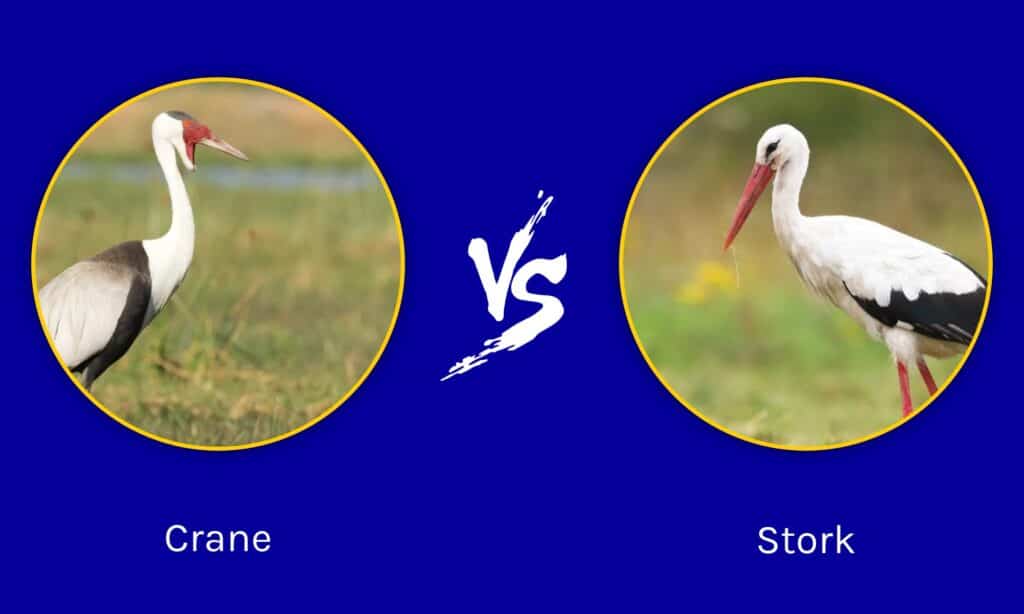Cranes and storks have one physical similarity: they belong to families of birds with long necks and legs. Besides, they are both diurnal flying birds. But this doesn’t make them the same birds. If you’re not a bird expert, you may be unable to tell the differences between these two birds. In this post, you’ll be able to learn the main differences between a crane and a stork. Let’s get to it!
Comparing a Crane and a Stork

| Crane | Stork | |
|---|---|---|
| Taxonomy | -Belongs to the Gruidae family | -Belongs to the Ciconiidea family |
| Physical Features and Appearance | -Height: 3.3ft-4.3ft -Weight: 8.2lbs – 22lbs -Wingspan: 7.9ft -Doesn’t have webbed toe | -Height: 3ft-4ft -Weight: 7.5lbs -Wingspan: 10.5ft -Has webbed toe |
| Habitat | -Found in wet areas | -Adapted to dry environment |
| Behavior | -Social behavior depends on the season -Generally more social | -Social behavior depends on species -Generally less social |
| Diet | -Omnivore | -Carnivore |
| Lifespan | -Average lifespan is 15-30 years | -22 years in wild, 35 years in captivity |
The Key Differences Between A Crane and A Stork
The key differences between a crane and a stork are their taxonomy, physical features, behavior, diet, and lifespan. While cranes belong to the Gruiformes order, storks belong to the Ciconiidae order. Besides, storks are generally shorter but bigger than cranes. And while storks are omnivores, cranes are carnivores.
But these are not the only differences between the two birds. Let’s explore the differences between a crane and a stork in detail!
Crane vs. Stork: Taxonomy
Cranes are birds from the Gruidae family and are classified under the Gruiformes order. Storks, on the other hand, are a group of birds belonging to the Ciconiiformes order. They are classified under the family of Ciconiidae birds. Besides, 19 different species of storks exist, whereas only 15 species exist for cranes.
Crane vs. Stork: Physical Features and Appearance

Storks have wingspans that are as wide as 10.5 feet.
©Blount Photography/Shutterstock.com
Cranes and storks have similar physical characteristics of long necks and legs. However, they differ in height, weight, and wingspan.
The weight and height of both birds largely depend on their species. But generally, storks are shorter than cranes, with the former having an average height that varies between 3 feet to 4 feet. Moreover, storks usually weigh more; the average adult weighs about 7.5 pounds. Interestingly, large species like the marabou stork can weigh up to 17.6 pounds.
In contrast, a crane bird can measure up to 8.2 and 22 pounds in weight and grow as tall as 3.3 to 4.3 feet. The sarus crane is almost as heavy as the marabou stork. It weighs about 17.2 pounds and is, in fact, the tallest flying bird.
Speaking of their wingspans, storks have wider wingspans. On average, storks have wingspans that are as wide as 10.5 feet. But the wingspan of a crane measures about 7.9 feet on average.
Additionally, other features that distinguish both birds are their beaks and toes. Cranes have smaller beaks than storks. And while cranes don’t have webbed feet, storks do.
Crane vs. Stork: Distribution, Habitat, and Range

Typically, cranes are found in wet areas.
©Wang LiQiang/Shutterstock.com
Cranes have a wide range and are found in several parts of the world except in Antarctica and South America. East Asia and Africa have the highest number of species. Some species are native only to certain parts of the world. For instance, the Balearica genus consists of two species that can only be found in Africa, while the Leucogeranus genus is in Asia.
Similarly, storks are found in several parts of the world, although they have a lesser range than their counterparts. Storks are most common in sub-Saharan Africa, Europe, and Asia. Although Australasia is home to the black-necked stork, these birds are rare to find in many parts of Australia and North America. It’s also rare to find them in the poles.
Typically, cranes are found in wet areas, so they mostly roost on water surfaces. But there is the exception of the African crowned cranes that prefer to stay in trees. On the other hand, storks are more adapted to dry environments. They usually build their nests on rocks and trees.
Crane vs. Stork: Behavior
While the social behavior of cranes depends on the season, that of storks largely depends on the species. Cranes are primarily social birds that prefer communal existence. They usually roost together. However, during the breeding season, they may isolate themselves to mate and remain in the same territory till the season is over.
The social behavior of storks is quite different from that of their counterparts. Some species (like the white stork and wood stork) are inherently more social than the others. So, while it’s common to see the likes of white storks nest together, you may find the other species (like the black-necked stork, saddle-billed stork, and jabiru stork) living solitary lives. And like cranes, some stork species that are usually friendly may remain solitary during the breeding season.
But that is not all. One more interesting dissimilar behavior between both birds is how clamorous they are. While cranes are known to be highly vocal birds, storks aren’t. The main reason for this is that storks, like tracheophone birds, have thin-walled syrinxes. So, they are unable to vocalize typical bird sounds. Their bill, however, can create sounds by clasping them together.
Crane vs. Stork: Diet

Storks are carnivores that eat fish, worms, and frogs.
©iStock.com/nedomacki
Unlike storks, cranes are opportunistic feeders. They are omnivores and can adapt to different diets depending on the availability and nutritional requirement. Their diet consists primarily of fruit, berries, seeds, nuts, leaves, acorns, worms, insects, snails, mammals, birds, and reptiles.
On the other hand, storks are carnivores and have a restricted diet. They mostly feed on tiny animals like fish, worms, frogs, and small land animals.
Crane vs. Stork: Reproduction and Lifespan
Both birds are seasonal breeders, but cranes lay only two eggs per season while storks lay between three to six eggs per season. During the breeding season, female cranes lay eggs on nests built on water surfaces with their mates. The breeding season depends on species. White storks usually breed between March and April, whereas wood storks breed between December and August. The season may also be affected by location. In South America, wood storks breed between June and October. But in North America, they do so between December and August.
On the other hand, storks build their nests with plant materials. They usually roost in trees, and after the egg is laid, both parents are involved in incubating it. Breeding season for cranes also depends largely on the species. For the sandhill species, the breeding season lasts from late April to Early May. But for the whooping crane, it lasts from April to June.
Generally, cranes live longer than storks. The average lifespan of a crane is usually between 15 to 30 years in the wild. But in captivity, they may survive for up to 80 years. On the other hand, storks live an average of 22 years in the wild. However, when in captivity, their lifespan can extend to 35 years.
The photo featured at the top of this post is © iStock.com/kellington1
Thank you for reading! Have some feedback for us? Contact the AZ Animals editorial team.







